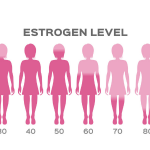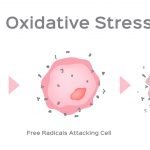Estrogen Dominance: When an Unhealthy Gut Estrobolome is to Blame
Naturopathic Perspective
Carrie Jones, ND, MPH
It is well established that elevated estrogen can pose many problems for both men and women. Not only can it result in estrogen dominance symptoms; if not properly detoxified, it increases the risk of several cancers. When patients present with elevated laboratory levels of estrogen and/or have symptoms related to excess estrogen, strategies often include supplements such as diindolylmethane (DIM) or indole-3-carbinol (I3C). While DIM and I3C can be effective at lowering estrogen levels, they only impact phase-1 of estrogen metabolism. Frequently overlooked are the phase-2 and -3 processes that play major roles in the safe excretion of this hormone. It is critical to consider all phases of metabolism, including the intestinal microbiome’s important role in facilitating proper excretion of estrogen metabolites; impairments in this step can have a significant effect on the patient’s health. By having a clearer understanding of each step and making sure to focus on proper gut health, practitioners can help mitigate potential risks in the future.
Estrogen Metabolism
Phase-1 Detoxification
Estrone (E1) and estradiol (E2) are the primary estrogens in the body. Primarily in the liver, they both undergo hydroxylation by members of the cytochrome P450 (CYP450) enzymes, which attach a hydroxyl (-OH) group to the estrogen.
- 2-hydroxyestrone (2-OH) is formed primarily through CYP1A1
- 4-OH is formed primarily through CYP1B1
- 16α-OH is formed primarily through CYP3A4
This group is known collectively as phase-1 estrogen metabolites, although they can be rather reactive themselves.1 Among the 3 metabolites, the 2-OH metabolite is generally considered the “safest” and the predominantly preferred metabolite because of its weak binding capacity to the estrogen receptor and its modest proliferative effects. In contrast, the 16α-OH metabolite can bind strongly to the estrogen receptor and has quite strong proliferative effects. However, it is important to keep in mind that estradiol itself is inherently proliferative. If an unhealthy microbiome allows for increased reabsorption of E2 into the general circulation, the effects will be much more impactful on the body than those of 16α-OH. The 4-OH metabolite has the potential to promote high cancer risk if it is unable to proceed through phase-2 detoxification.1 In such a case, 4-OH can head down a different pathway to become the free radical, 3,4-quinone, that reacts with DNA and forms depurinating estrogen DNA adducts.2,3
Phase-2 Detoxification
The phase-1 estrogen metabolites, 2-OH and 4-OH, are inactivated in Phase-2 detoxification primarily by methylation via the enzyme catechol-O-methyltransferase (COMT).4 Other phase-2 pathways include sulfation and glucuronidation. Importantly, it is the estrogen glucuronide conjugate (from glucuronidation) that can become the target of gut bacteria during phase 3, as discussed in the next section. Phase-2 metabolites are relatively inert and water-soluble, which allows them to be easily excreted via the kidneys as well as the gastrointestinal tract. Phase-1 and phase-2 detoxification can thus be evaluated using urine hormone testing. Following phase-2 metabolism, the inactive metabolites that are transported to the bile then enter what is colloquially known as phase-3 detoxification in the intestine.
Phase-3 Intestinal Detoxification
For the estrogen that is conjugated or “packaged up” and delivered to the bile for “safe” excretion, a healthy intestinal tract is critical in order to minimize reabsorption of the hormone. Unfortunately for many, this is not always the case. In a 2016 study, women were injected with radio-labeled estrogen. These estrogens were expected to be found in their conjugated (detoxified) forms in the subjects’ feces. Surprisingly, researchers found that 65% of the estradiol had reversed to its unconjugated (active) form, which can be easily reabsorbed from the intestine.5 It turns out that high levels of the bacterial enzyme, beta-glucuronidase, made by an unhealthy estrobolome, was to blame.
The Estrobolome
What is the estrobolome? It has been described as “the aggregate of enteric bacterial genes whose products are capable of metabolizing estrogens, [and which] acts on conjugated estrogens and estrogen metabolites, with downstream physiologic effects.”6 Much like the rest of the microbiome, the estrobolome is easily influenced by factors such as diet, lifestyle, antibiotic use, history of vaginal delivery (or not), age, and alcohol use.5,6
While the Human Microbiome Project found over 50 species of gut bacteria that can encode for beta-glucuronidase, they can be grouped into 4 main phyla: Bacteroidetes, Firmicutes, Verrucomicrobia, and Proteobacteria.7 Beta-glucuronidase has a bad reputation. However, the enzyme has an important role in breaking down complex carbohydrates and facilitating the reabsorption of bilirubin and flavonoids.8 Much like the Goldilocks story, humans need just the right balance.
Unfortunately, estrogen-dominance symptoms like PMS or menorrhagia are not the only potential problems associated with elevated beta-glucuronidase levels. Studies have shown that obesity, metabolic syndrome, estrogen-related cancers, uterine hyperplasia, endometriosis, infertility, cognitive function, and cardiovascular disease may all be directly impacted.9 This is why appropriate testing and treatment is so important to a person’s overall health.
Many stool companies testing for bacteria, candida, parasites, and gastrointestinal inflammation also measure fecal beta-glucuronidase levels. Treatment for borderline-elevated or elevated levels centers around key factors such as lifestyle modification and appropriate supplementation, as well as addressing any other intestinal imbalances.
Treatment
As the popular saying goes, we are what we eat and absorb. Therefore, advise patients to work on eliminating or reducing sugar and processed foods or other choices commonly considered part of the “standard American diet.” Focus on a diet rich in organic vegetables, fruit, and fiber. Research has shown that a shift in the diet can induce microbial shifts within 24 hours!10 This means those fried fatty foods eaten yesterday can have a direct impact on the microbiome – including the estrobolome and estrogen reabsorption – today.
Be mindful of antibiotic use and work to reduce or eliminate toxicant exposure, as both have a direct impact on the microbiome.11-14 Advise patients to read labels, minimize use of plastic water bottle and food containers (especially when heated), decline the thermal receipts printed at stores, filter drinking water, opt for organic food whenever possible, consider an air filter for the house if necessary, and to be mindful of what they put on their bodies and use in their homes and out in their yards.12-15
Honestly discuss alcohol consumption with your patients, as it has an impact not only on the gut microbiome but also on the ability of the liver to properly detoxify circulating estrogens (and endocrine-disrupting chemicals); these impairments can contribute to estrogen dominance symptoms and/or an increased risk of estrogen-related cancers.16-19
Consider supplementation with prebiotics and/or probiotics to help with dysbiosis while also addressing any infections that might have been revealed by stool testing.10 Lastly, the supplement calcium-D-glucarate is a known beta-glucuronidase inhibitor, allowing estrogen to remain conjugated or “packaged for excretion” and safely eliminated from the body. The typical dosage of calcium-D-glucarate is 1500-3000 mg/day; however, animal research tends to use 100-200 mg/kg, which may indicate that traditional dosing for humans is on the low side.20,21 Nevertheless, every little bit does help. Currently, there are no known toxic effects of calcium-D-glucarate in animal studies.20
Focusing on gut health has always been a mainstay in naturopathic practices, and with estrogen issues, it is no different. By understanding the detoxification process from start to finish, practitioners can further tailor individual treatment plans for their patients and help eliminate or reduce risk.
References:
- Moore SC, Matthews CE, Ou Shu X, et al. Endogenous Estrogens, Estrogen Metabolites, and Breast Cancer Risk in Postmenopausal Chinese Women. J Natl Cancer Inst. 2016;108(10).
- Cavalieri E, Chakravarti D, Guttenplan J, et al. Catechol estrogen quinones as initiators of breast and other human cancers: implications for biomarkers of susceptibility and cancer prevention. Biochim Biophys Acta. 2006;1766(1):63-78.
- Cavalieri EL, Rogan EG. Depurinating estrogen-DNA adducts, generators of cancer initiation: their minimization leads to cancer prevention. Clin Transl Med. 2016;5(12):1-15.
- Ho PW, Tse ZH, Liu HF, et al. Assessment of cellular estrogenic activity based on estrogen receptor-mediated reduction of soluble-form catechol-O-methyltransferase (COMT) expression in an ELISA-based system. PLoS One. 2013;8(9):e74065.
- Kwa M, Plottel CS, Blaser MJ, Adams S. The Intestinal Microbiome and Estrogen Receptor-Positive Female Breast Cancer. J Natl Cancer Inst. 2016;108(8).
- Plottel CS, Blaser MJ. Microbiome and malignancy. Cell Host Microbe. 2011;10(4):324-335.
- Pollet RM, D’Agostino EH, Walton WG, et al. An Atlas of β-Glucuronidases in the Human Intestinal Microbiome. Structure. 2017;25(7):967-977.
- Vitek L, Carey MC. New pathophysiological concepts underlying pathogenesis of pigment gallstones. Clin Res Hepatol Gastroenterol. 2012;36(2):122-129.
- Baker JM, Al-Nakkash L, Herbst-Kralovetz MM. Estrogen-gut microbiome axis: Physiological and clinical implications. Maturitas. 2017;103:45-53.
- Singh RK, Chang HW, Yan D, et al. Influence of diet on the gut microbiome and implications for human health. J Transl Med. 2017;15(1):73.
- Velicer CM, Heckbert SR, Lampe JW, et al. Antibiotic use in relation to the risk of breast cancer. JAMA. 2004;291(7):827-835.
- Javurek AB, Spoilen WG, Johnson SA, et al. Effects of exposure of bisphenol-A and ethinyl estradiol on the gut microbiota of parents and their offspring in a rodent model. Gut Microbes. 2016;7(6):471-485.
- Velmurugan G, Ramprasath T, Gilles M, et al. Gut microbiota, endocrine-disrupting chemicals, and the diabetes epidemic. Trends Endocrinol Metab. 2017;28(8):612-625.
- Koppel N, Maini Rekdal V, Balskus EP. Chemical transformation of xenobiotics by the human gut microbiota. Science. 2017;356(6344).
- Ehrlich S, Calafat AM, Humblet O, et al. Handling of thermal receipts as a source of exposure to bisphenol A. JAMA. 2014;311(8):859-860.
- Endogenous Hormones and Breast Cancer Collaborative Group, Key TJ, Appleby PN, et al. Circulating sex hormones and breast cancer risk factors in postmenopausal women: reanalysis of 13 studies. Br J Cancer. 2011;105(5):709-722.
- Hamajima N, Hirose K, Tajima K, et al. Alcohol, tobacco and breast cancer—collaborative reanalysis of individual data from 53 epidemiological studies, including 58,515 women with breast cancer and 95,067 women without the disease. Br J Cancer. 2002;87(11):1234-1245.
- Erol A, Ho AM, Winham SJ, Karpyak VM. Sex hormones in alcohol consumption: a systematic review of evidence. Addict Biol. 2017 Dec 27. doi: 10.1111/adb.12589. [Epub ahead of print]
- Kolak A, Kamińska M, Sygit K, et al. Primary and secondary prevention of breast cancer. Ann Agric Environ Med. 2017;24(4):549-553.
- Patel K. Calcium-D-Glucarate. Last updated June 14, 2018. Available at: https://examine.com/supplements/calcium-d-glucarate/. Accessed September 7, 2018.
- [No authors listed]. Calcium-D-glucarate. Altern Med Rev. 2002;7(4):336-339.
- Photo by Juan Jose on Unsplash
 Carrie Jones, ND, MPH, is an internationally recognized speaker, consultant, and educator on the topic of women’s health and hormones. Dr Jones graduated from NUNM in Portland, OR, where she also completed her 2-year residency in women’s health, hormones, and endocrinology. She later graduated from Grand Canyon University’s Master of Public Health program, with a goal of doing more international education. She was adjunct faculty for many years, teaching gynecology and advanced endocrinology/fertility, and has been the Medical Director for 2 large integrative clinics in Portland. Dr Jones is the Medical Director for Precision Analytical, Inc, creators of the DUTCH hormone test.
Carrie Jones, ND, MPH, is an internationally recognized speaker, consultant, and educator on the topic of women’s health and hormones. Dr Jones graduated from NUNM in Portland, OR, where she also completed her 2-year residency in women’s health, hormones, and endocrinology. She later graduated from Grand Canyon University’s Master of Public Health program, with a goal of doing more international education. She was adjunct faculty for many years, teaching gynecology and advanced endocrinology/fertility, and has been the Medical Director for 2 large integrative clinics in Portland. Dr Jones is the Medical Director for Precision Analytical, Inc, creators of the DUTCH hormone test.









